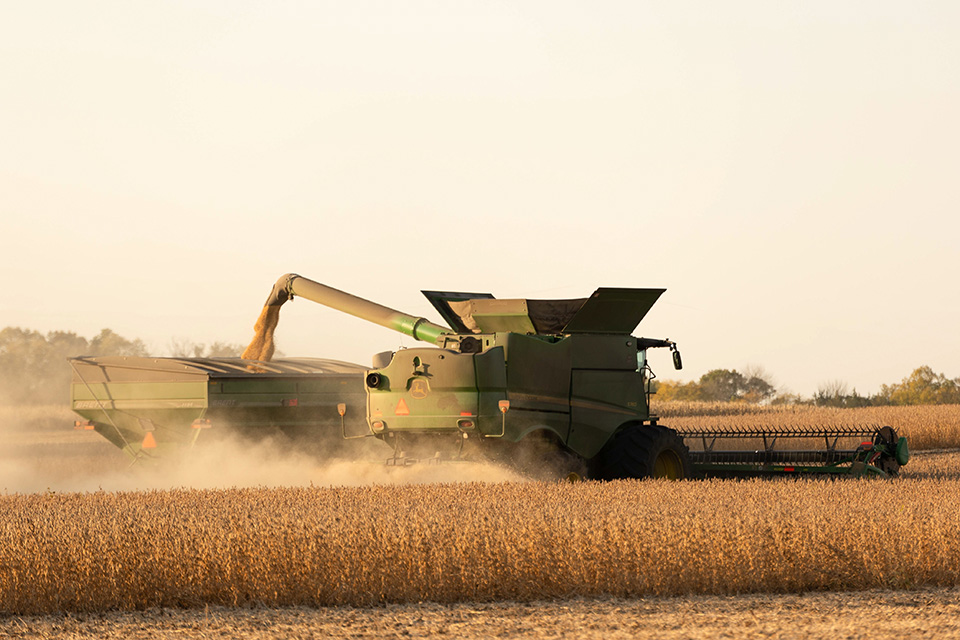
(Photo: Iowa Soybean Association / Joclyn Bushman)
Post-harvest strategies amidst market volatility
October 19, 2023
In between raindrops as they navigate from the seat of their tractors and combines, many of Iowa’s soybean farmers are nearing the finish line for this year’s harvest.
But once the beans have been harvested, Iowa Soybean Association farmer-members are focused well beyond what’s happening right now in the fields.
For Brent Wells of rural Fonda, grain markets are top of mind.
“Right now, we’re wondering should we be selling or storing grain,” he says. “We’re thinking about interest rates and wondering if we should hold on to our grain now. We’re always looking at what the markets are doing, but I think in the last couple of years, it seems more volatile. The swings are so big anymore. It’s not just 20 cents on corn and 50 cents beans; the numbers are bigger. The implications are such that they’re going to have a huge impact on your bottom line.”
Wells is also thinking about spring 2024 planting.
“We’re evaluating some of the new products we’ve tried,” he says. “We’re looking at a lot of biologicals – we need to evaluate those results over the winter and determine whether we want to incorporate them in our program.”
But perhaps even more important for Wells is the retirement of his father after this season’s harvest.
“We’ll be taking over more acres next year, so we’re working through that transition,” he says. “We still need to get the equipment appraised and get those details ironed out, as well as all our crop decisions.
“I will need to be more disciplined with my numbers, needing to understand even more my break-evens, my financials, prices and what our realistic yield goals should be.”
In rural Jasper County outside of Colfax, Will Cannon is still looking to the skies. Dry weather has been a concern for most of 2023.
“We have a creek that runs through the farm,” he says. “That creek bed was completely dry. We need some rain soon.”
Like Wells, Cannon says he will be looking at biologicals and analyzing information on the yield monitors during harvest to determine where he might be more profitable next season.
“We’re really looking ahead to figure out what our long-term sustainability goals are,” he says.
Cannon is also focused on the future of his operation and its expansion.
“For us, we’ve been trying to buy out a retiring business and we’re making the last payment this winter,” he says. “It’s a big achievement, a big milestone. For the first time, I’m starting to feel financially secure.”
“We started small, but we’ve built up some working capital, but things are paid down. It’s a little bit of a sigh of relief.”
But with that, Cannon says inflationary concerns, market unpredictability and input costs reminiscent of 2013-14, he’s even more observant as to what his next steps should be.
“We need to be more protective going forward,” he says. “I think we’re going to be a little more strategic in continuing to build up that working capital.”
Reed Burres understands Cannon’s concerns, having just bought his first farm last year.
“Grain prices have fallen out of bed. We have good crop insurance coverage, but that’s not everything,” he says from his Humboldt County operation.
Burres says he’s eyeing what’s going on in Washington, D.C.
“I’ve never really considered myself a political person at all, but I do wonder if there’s just a little bit too much oversight and too much control over inflation. I’m excited about the future, but I’m trying to be patient to see what happens come next spring.”
Burres says like most farmers, he’s not just focused on what’s happening in his fields at the present, but what needs to be addressed in the spring and beyond.
“We’ve seen a bit of a turnaround on some input prices, so we have some of those things locked in for 2024,” he says.
Burres is also hoping for an uptick in export numbers and what that might mean for the future of his soybean crop.
He says there needs to be a bigger push toward selling more soybeans to emerging markets to help with soybean farmers’ bottom line.
“I would like to see some improvements with that, but we’ll just have to see.”
Back